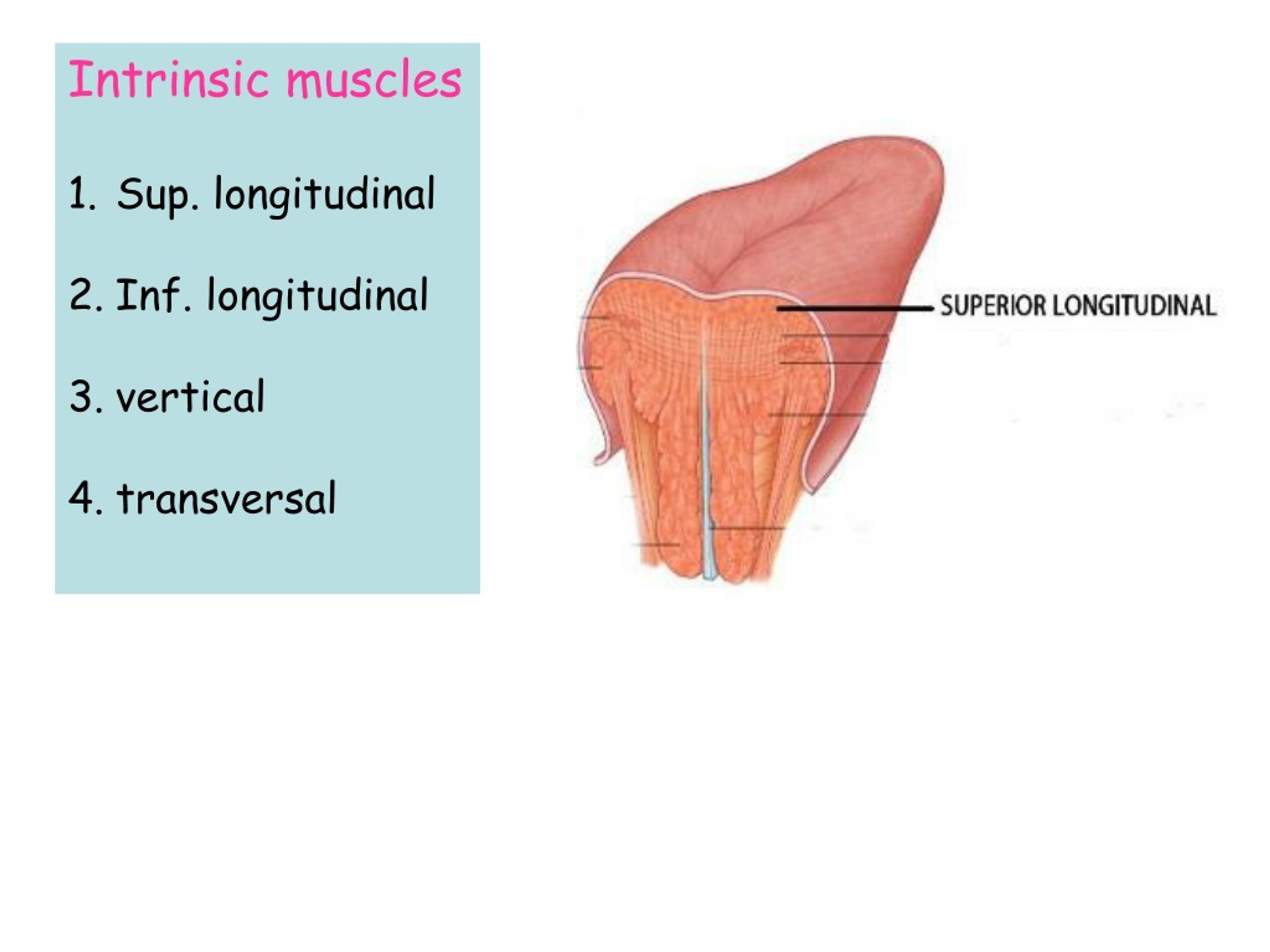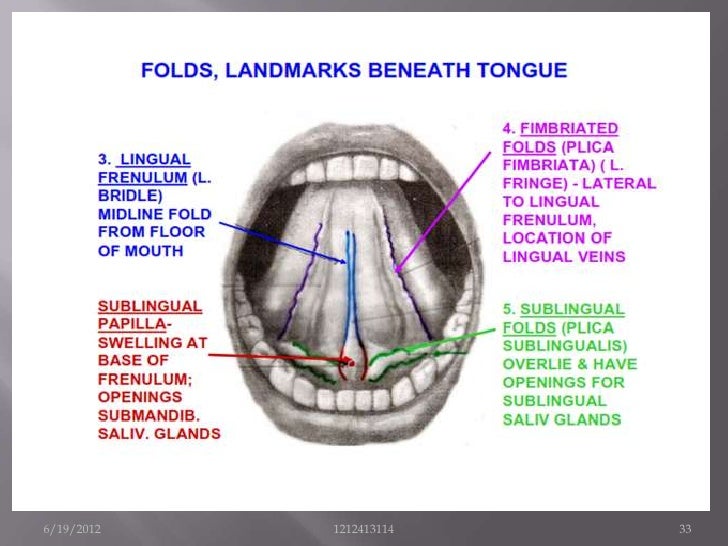
Related image Anatomy of the tongue, Anatomy, Human tongue
In 33.3%, one of the terminal branches of the mylohyoid nerve after perforating the homonymous muscle, anastomoses with the lingual nerve in the lateral sulcus of the tongue (Sulcus lateralis linguae) achieving, in the author's opinion, the "mylohyoid or sublingual curl".

PPT Dr. Altdorfer The tongue Anatomy, histology, innervation PowerPoint Presentation ID
Surgical Anatomy of the Tongue Mahmoud F. Sakr Chapter First Online: 24 August 2022 609 Accesses Abstract The tongue (Latin, lingua; Greek, glos sa) is a unique organ located in the oral cavity. It has importance in the digestive system and is the primary organ of taste in the gustatory system.

Tongue muscles, Anatomy, Anatomy of the tongue
The lateral lingual groove (or sulcus) is a V-shaped space located between the hyoglossus and mylohyoid muscles. Figure 1. Lateral lingual groove Subscribe now to continue reading Join hundreds of successful students who use Meddists to ace their exams. Gain access to all of the material and topics, custom-made just for you. Continue
:watermark(/images/watermark_only.png,0,0,0):watermark(/images/logo_url.png,-10,-10,0):format(jpeg)/images/anatomy_term/arteria-dorsalis-linguae/brdasWhvZZ9Coh8ZOGsE0Q_A._dorsalis_linguae_01.png)
Tongue Nerve and blood supply (lingual artery) Kenhub
When looking at the lateral surface of the cerebrum, we can recognize the lateral sulcus as a deep groove that separates the temporal lobe below from the frontal lobe above. This groove has a central part at the base of the brain, which becomes clearer when viewed from the lower side. From there, it extends sideways between the frontal and temporal lobes. As it reaches the outer surface of the.

Sulcus lateralis Ars Neurochirurgica
Der Sulcus lateralis linguae (lat. für „seitliche Zungenfurche") ist ein zwischen dem Zungenboden und Unterkieferknochen verlaufender dreiseitiger Spalt bzw. Kanal. Er wird oben durch den Musculus hyoglossus, unten durch den Musculus mylohyoideus und seitlich durch den Unterkiefer begrenzt.
:watermark(/images/logo_url.png,-10,-10,0):format(jpeg)/images/anatomy_term/arteria-lingualis-2/7URLOLjzx5gRwRvXyrUIw_A._lingualis_m01.png)
Tongue Nerve and blood supply (lingual artery) Kenhub
Definition. The median sulcus divides the dorsum of the tongue into symmetrical halves; this sulcus ends behind, about 2.5 cm. from the root of the tongue, in a depression, the foramen caecum, from which a shallow groove, the sulcus terminalis, runs lateralward and forward on either side to the margin of the tongue.

PPT 23 PowerPoint Presentation, free download ID2246527
The Sylvian fissure, also known as the lateral sulcus or fissure, begins near the basal forebrain and extends to the lateral surface of the brain separating the frontal and parietal lobes superiorly from the temporal lobe inferiorly 3.The insula is located immediately deep to the Sylvian fissure.. Gross anatomy. The Sylvian fissure can be divided into superficial and deep portions 3,4.

Nose and tongue
In neuroanatomy, the lateral sulcus (also called Sylvian fissure, after Franciscus Sylvius, or lateral fissure) is one of the most prominent features of the human brain. The lateral sulcus is a deep fissure in each hemisphere that separates the frontal and parietal lobes from the temporal lobe.

Human Anatomy Scientific Illustrations Nervus Lingualis HighRes Vector Graphic Getty Images
The lateral sulcus is a deep cleft in each hemisphere that divides the frontal and parietal lobes from the temporal lobe. The insular cortex lies deep within the lateral sulcus. This part of the brain plays a role in sensory experience and emotional valence(2). The lateral sulcus is one of the earliest-developing sulci (fissures) of the human.
:watermark(/images/watermark_only.png,0,0,0):watermark(/images/logo_url.png,-10,-10,0)/images/anatomy_term/terminal-sulcus-of-tongue/BQMiolUVECN7aPO1fd5Shg_Sulcus_terminalis_02.png)
Terminal sulcus of tongue (Sulcus terminalis linguae) Kenhub
Dr. Altdorfer: The tongue - Anatomy, histology, innervation Sulcus terminalis Foramen cecum Root Follicular part Dorsum linguae Papillar part Apex linguae. Intrinsic muscles • Sup. longitudinal • Inf. longitudinal • vertical • transversal. SUBLINGUAL REGION • frenulumlinguae • deeplingualvein • sublingual fold • sublingualcaruncula (papilla)

Reference points used for measurements on the casts (A) lingual sulcus... Download Scientific
The lateral sulcus (sulcus lateralis of Sylvius), known for a long time as the Sylvian fissure, between the frontal and temporal lobes, has three branches: the anterior (ramus anterior) or horizontal ramus, the ascending (ramus ascendens) or vertical ramus and the posterior ramus (ramus posterior), separating the parietal and temporal lobes.

TONGUE Anatomy for MBBS, NEET PG, AIIMS PG, FMGE & ALL PG YouTube
The sulcus lateralis linguae (Latin for "lateral tongue furrow") is a three-sided gap or canal running between the base of the tongue and the lower jaw bone. It is bounded above by the hyoglossus muscle, below by the mylohyoid muscle and laterally by the lower jaw.. The structures running in it are from top to bottom: Nervus lingualis; Sublingual vein (variable)

1st week _digestive_system_i
Citation, DOI, disclosures and article data. Ascending ramus of the lateral sulcus, is located at the anterior end of the lateral sulcus (sylvian fissure), just posterior to the anterior ramus, and passes superiorly into the inferior frontal gyrus separating the pars triangularis from the pars opercularis of the frontal operculum.

PPT Trávicí systém (apparatus digestorius) PowerPoint Presentation ID4148661
hard and soft palate mucosa overlying sublingual and submandibular glands + tongue. buccal mucosa ROOF Palate ORAL CAVITY PROPER LATERAL WALL Bucca TONGUE Sulcus paralingualis FLOOR Oral diaphragm

theanatomyofthetongue Google Search Anatomy Head, Anatomy Bones, Body Anatomy, Anatomy Of
SULCUS LATERALIS LINGUAE SULCUS MEDIALIS LINGUAE Határai: medialis: m. hyoglossus lateralis: m. mylohyoideus felső: paralingualis nyálkahártya Tartalma: n. lingualis d. submandibularis n. hypoglossus + * v. comitans cum nervo hypoglosso.

Pin by Will Housell on Lickilicky Throat anatomy, Tongue, Anatomy
The torus linguae, a raised portion of the tongue caudal to the lingual fissure. The buccal papillae, are conical papillae lining the inside of the cheeks. The surface of the tongue is covered in papillae, including the large round vallate papillae (with a moat encircling each one) near the root of the tongue.